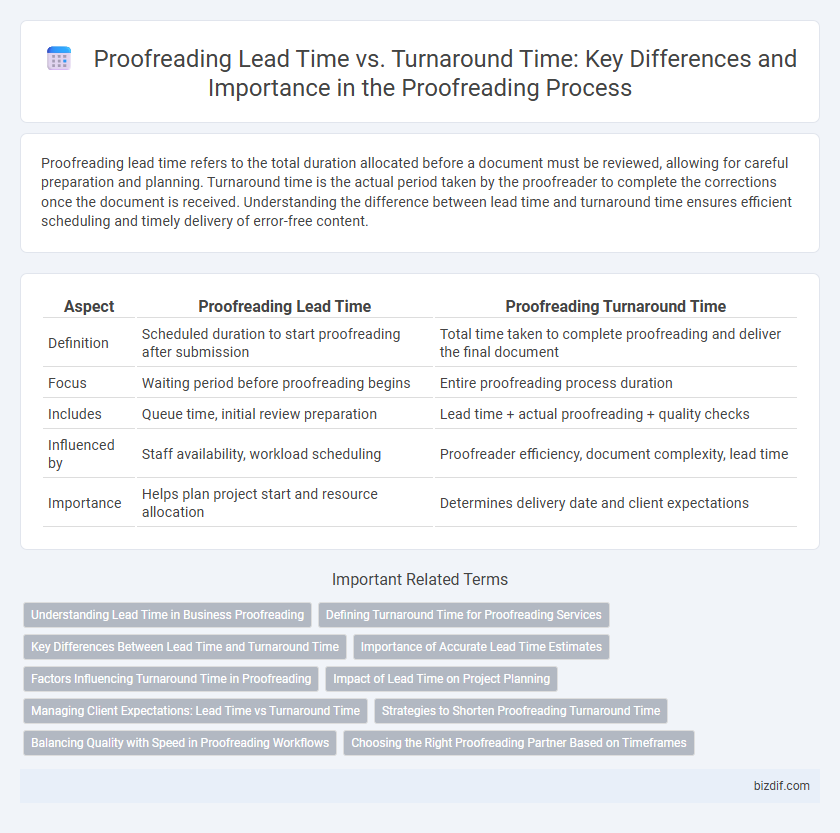Proofreading lead time refers to the total duration allocated before a document must be reviewed, allowing for careful preparation and planning. Turnaround time is the actual period taken by the proofreader to complete the corrections once the document is received. Understanding the difference between lead time and turnaround time ensures efficient scheduling and timely delivery of error-free content.
Table of Comparison
| Aspect | Proofreading Lead Time | Proofreading Turnaround Time |
|---|---|---|
| Definition | Scheduled duration to start proofreading after submission | Total time taken to complete proofreading and deliver the final document |
| Focus | Waiting period before proofreading begins | Entire proofreading process duration |
| Includes | Queue time, initial review preparation | Lead time + actual proofreading + quality checks |
| Influenced by | Staff availability, workload scheduling | Proofreader efficiency, document complexity, lead time |
| Importance | Helps plan project start and resource allocation | Determines delivery date and client expectations |
Understanding Lead Time in Business Proofreading
Understanding lead time in business proofreading is crucial for managing client expectations and project deadlines. Lead time refers to the total duration from receiving the document to delivering the finalized text, encompassing initial review, editing, and quality checks. Optimizing lead time ensures efficient workflow, minimizes delays, and enhances overall client satisfaction by providing timely and accurate proofreading services.
Defining Turnaround Time for Proofreading Services
Turnaround time for proofreading services refers to the total period from when a document is submitted until the finalized, error-free version is delivered to the client. This timeframe encompasses all stages including initial review, error correction, and final quality checks. Understanding the distinction between lead time and turnaround time helps clients set realistic expectations for project completion and resource allocation.
Key Differences Between Lead Time and Turnaround Time
Lead time in proofreading refers to the total duration from the initial receipt of the document to the final delivery of the polished text, encompassing all stages including review and revisions. Turnaround time specifically measures the period required to complete the actual proofreading process, starting from when the document is handed over to the proofreader until the proofread text is returned. Understanding these distinctions helps in setting realistic deadlines and managing client expectations in professional editing workflows.
Importance of Accurate Lead Time Estimates
Accurate lead time estimates in proofreading are crucial for managing client expectations and ensuring project deadlines are met consistently. Misestimating lead time can lead to rushed work, increased errors, and compromised quality, negatively impacting client satisfaction and company reputation. Precise turnaround time calculations allow for efficient resource allocation and smooth workflow management, ultimately enhancing overall productivity.
Factors Influencing Turnaround Time in Proofreading
Turnaround time in proofreading depends on factors such as document length, complexity, and the level of detail required for error detection. The availability and expertise of proofreaders also significantly impact the speed of review and revision processes. Client requirements for multiple review rounds and formatting adjustments further contribute to variations in turnaround time.
Impact of Lead Time on Project Planning
Proofreading lead time directly influences turnaround time by determining the earliest point at which review begins, impacting overall project scheduling and delivery deadlines. Extended lead times allow for thorough error detection and correction, reducing the risk of rushed revisions and enhancing final content quality. Effective project planning incorporates realistic lead times to allocate sufficient resources, ensuring timely completion without compromising accuracy.
Managing Client Expectations: Lead Time vs Turnaround Time
Managing client expectations requires clear communication about proofreading lead time versus turnaround time to avoid misunderstandings and ensure satisfaction. Lead time refers to the total duration required from project initiation to completion, including preparation and review stages, while turnaround time specifically denotes the period allocated for the actual proofreading process. Setting realistic lead times and transparently explaining the distinction helps clients anticipate project milestones and allocate resources effectively.
Strategies to Shorten Proofreading Turnaround Time
Strategies to shorten proofreading turnaround time include implementing real-time collaboration tools and using automated proofreading software that quickly detects errors. Allocating dedicated proofreading schedules and prioritizing documents based on project deadlines can significantly reduce lead time without compromising quality. Streamlining communication between writers and proofreaders ensures faster revisions and accelerates overall turnaround.
Balancing Quality with Speed in Proofreading Workflows
Proofreading lead time refers to the total duration allocated for reviewing and correcting documents before final delivery, while turnaround time measures the actual period from submission to completion. Balancing quality with speed in proofreading workflows requires optimizing lead time to ensure thorough error detection without compromising rapid turnaround commitments. Efficient project management systems and standardized quality checks enhance precision, enabling timely delivery without sacrificing accuracy.
Choosing the Right Proofreading Partner Based on Timeframes
Proofreading lead time refers to the scheduled period allocated for reviewing and correcting a document before the final deadline, while turnaround time indicates the actual duration taken to complete the proofreading task. Selecting the right proofreading partner requires evaluating their ability to consistently meet tight lead times without compromising quality, ensuring your project stays on schedule. Prioritize partners with transparent processes and proven track records in managing both standard and expedited turnaround requests.
Proofreading Lead Time vs Turnaround Time Infographic

 bizdif.com
bizdif.com